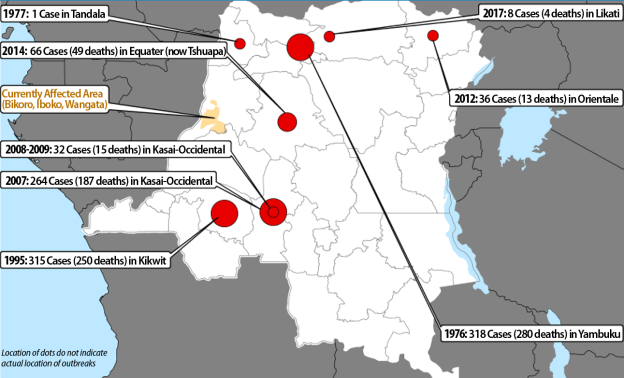On May 8, 2018, health officials from the Democratic Republic of Congo (DRC) reported to the World Health Organization (WHO) that two Ebola cases had been detected in the Equateur province, a rural area in the northwestern portion of the country. The disease has since spread to Mbandaka, a city that holds 1.2 million people and serves as a regional trade hub. As of June 10, 2018, WHO reported a total of 55 cases, including 28 deaths. Of these cases, 69% were confirmed through diagnostics. WHO asserts that 14 of these cases were probably Ebola, but could not collect laboratory specimens before the burial. This is the ninth Ebola outbreak in DRC since the disease was discovered in 1976, when an outbreak infected 318 people and killed 280 (Figure 1). WHO considers the public health risk of transmission to be very high at the national level due to the serious nature of the disease, insufficient epidemiological capacity, and delayed detection of the first case. At the global level, however, the risk is considered low. The outbreak appears to have been contained in the most populous areas and active transmission appears to be occurring only in rural areas.
The DRC's Ministry of Health, WHO, and other stakeholders are taking several steps to contain the outbreak. Notably, a new vaccine, used for the first time in the field during the 2014-2016 West Africa Ebola outbreaks, is now being provided to all primary and secondary contacts to prevent disease transmission. Merck provided more than 7,500 doses for the vaccination effort. In addition, health officials approved the use of investigational drugs to treat those infected with Ebola. This marks the first time in which investigational drugs are being used in the field during an outbreak.
Health experts are particularly troubled by this outbreak, as it is occurring in a city that is densely populated (2.5 million people) and hosts a portion of the Congo River that is vital for regional transportation. Previous outbreaks occurred primarily in sparsely populated, rural areas. The only other urban outbreak occurred in Kikwit in 1995, which held 400,000 people at the time. WHO has conducted operational readiness and preparedness assessments in the nine countries bordering the DRC, placing particular emphasis on the Central African Republic, due to its proximity to the outbreak area. The assessment plans are aimed at identifying operational needs should an outbreak occur and providing technical support for the development and implementation of contingency plans. WHO has "cautious optimism" that ongoing containment measures are working. The disease was once present in three health zones (Bikoro, Wangata, and Iboko) in Equateur province, and since May 17, all new cases were detected in the Iboko Health Zone.
WHO is seeking $56.7 million to control the Ebola outbreak through a coordinated approach across several international actors. As of June 3, 2018, donors have pledged $25.7 million. The United States committed to provide $8.0 million in support of Ebola control efforts in the country, drawing on $5.0 million in FY2017 appropriations for USAID-administered Global Health Program (GHP) funding. It is also drawing $3 million in GHP funds appropriated in FY2015 for Ebola response in West Africa. Roughly $5.0 million of the funds is to be provided to WHO for case management, entry screenings, diagnosis testing, and support for other laboratory functions. About $2.0 million is for the United Nations Children's Fund (UNICEF) to implement Ebola awareness communication campaigns and water, sanitation, and hygiene (WASH) projects. An estimated $700,000 is to be used by the International Federation of the Red Cross/Red Crescent Societies (IFRC) for promoting safe burial practices and Ebola prevention education campaigns.
On June 5, the White House withdrew proposed rescissions of $252 million in unobligated emergency International Disaster Assistance (IDA) funds appropriated in 2015 to control the West Africa Ebola outbreak and bolster response capacity in affected countries. These funds may be made available for ongoing Ebola control efforts in the DRC.
In addition, the U.S. Centers for Disease Control and Prevention (CDC) is working with partners to support the development and implementation of an outbreak response plan, as well as to provide technical assistance in communications, logistics, operational and personnel support, and laboratory capacity building. The United Nations peacekeeping operation in the DRC, to which the United States is the largest financial contributor, is also providing logistical support to response efforts.
